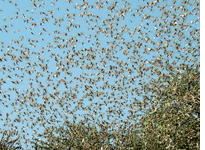Folk wisdom on locust breeding challenged
 ARCHI RASTOGI
ARCHI RASTOGI
it is said that locusts thrive in warm weather. Folk wisdom has it that the outbreaks of the oriental migratory locust (Locusta migratoria manilensis) follow either droughts or floods which allow the insect to breed fast.
A new study shows that less locusts are found in warmer conditions, signalling an inverse relationship with temperature. Researchers say that this doesn't mean that global warming could decrease locust infestations unless there is a change in associated rain patterns. They say differences in annual and decadal effects of climate on the locust need to be factored into global warming studies. "We do not think that the findings are directly applicable to locusts in India. However, the more general conclusions are important also in India in a global warming perspective,' says Nils C Stenseth of the University of Oslo, Norway, who led the research team.
Highly mobile and travelling in swarms locusts can strip cultivated fields in next to no time. Considering their devastating nature, potential locust outbreaks are constantly monitored across the globe. Though China had for long controlled locust outbreaks, it has recently witnessed the phenomenon. The outbreaks have been documented for over a thousand years in China. Relying on this long-term data researchers from Norway, Switzerland, the us and China have analysed the pattern of locust outbreaks by comparing them with average temperature and precipitation data over 10 year periods. The data was inferred from tree growth rings and lake sediments.
The results were published in the September 18 issue of the Proceedings of the National Academy of Sciences (Vol 104, No 38).
